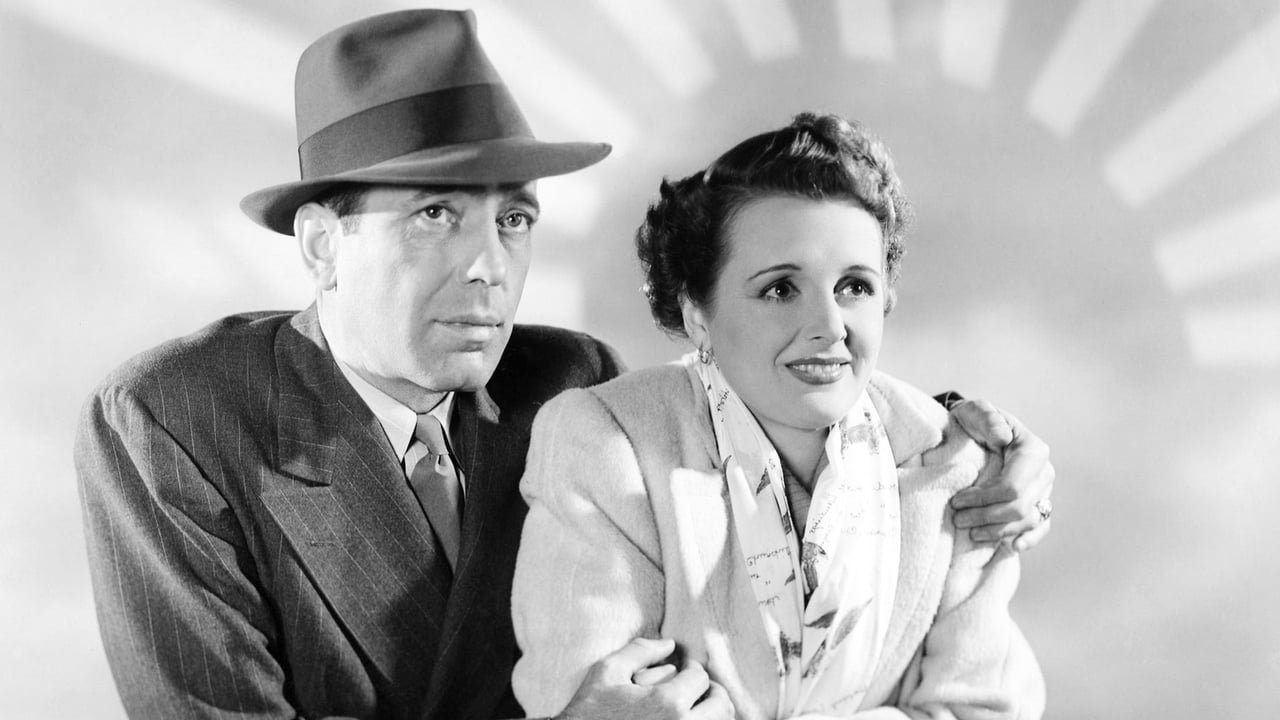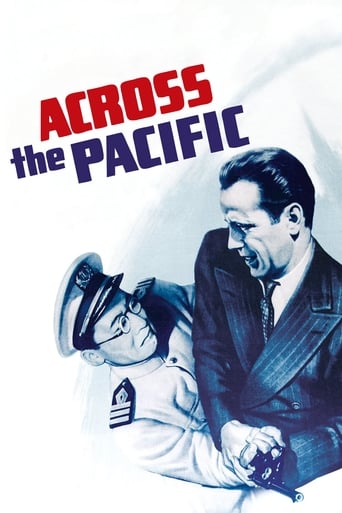

This general genre -- Americans fighting Nazism (or in this case the Japanese) before or during World War II, is generally not very high on my list of types of film to watch. However, every once in a while one comes along that is pretty decent, often because it's not as predictable.One thing that makes this particular film a cut above is the cast, much of which was fresh off the success of "The Maltese Falcon". This is a good vehicle for Humphrey Bogart, who plays a GI pretending to be kicked out of the military to act as a sort of spy on some Americans that are up to no good with the Japanese, scheduled right around the bombing of Pearl Harbor, However, in this case the action is taking place centered around the Panama Canal. The primary bad guy here is Sidney Greenstreet, in league with he Japanese. Greenstreet is suitably menacing here. The leading question among the characters is: is Bogart's love interest -- again Mary Astor, a good girl or a bad girl? I actually think Astor is better here than she was in "The Maltese Falcon".There are also many Asian character actors here that you will recognize, even if you don't remember their names: Victor Sen Yung, Richard Loo, and Keye Luke (among others). Another very good character actor here is Charles Halton.Of course, as some of our participants have pointed out, there is negative stereotyping of the Japanese in this film. Well, of course! It was made in the middle of World War II.The degree of suspense here is a little uneven, and there are times when the film moves a little too slowly (particularly in the first half of the film), but overall this film holds your attention.Sidney Greenstreet's love of Japanese culture is really quite entertaining. I never considered him a very versatile actor, but he was very good at what he did well.If there are any criticisms due here, there are two. First, the stunt doubling for Humphrey Bogart here is way too obvious. Second, some of the "special effects" here (such as the single airplane near the end of the film) is quite primitive. But, overall, these two things do not detract much from the enjoyment of the film; they may just make you smile.Recommended if you wish to savor a taste of John Huston's Hollywood version of patriotism. Quite well done for this genre.
... View MoreFilms made around this time always have an interesting behind the scenes story, and "Across the Pacific" from 1942 is no different.Rick Leland (Humphrey Bogart) is court-marshaled and booted out of the service; he then heads for Canada and attempts to enlist, but the Canadians know who he is and say they can't use him.Leland then leaves on a Japanese ship for the Orient, making no bones about the fact that his talents are for sale! He meets an attractive woman, Alberta Marlow (Mary Astor) and one Dr. Lorenz (Sidney Greenstreet). Lorenz loves the Japanese and its people, and speaks the language very well.You'll probably guess most of this.This is a Maltese Falcon template, with the exception of the absence of Peter Lorre. John Huston directed, but when we entered the war, he left to do documentary films for the government. Vincent Sherman started the film at a difficult moment in the action, and he asked Huston how a particular situation would be resolved. Huston said, "That's your problem!" and left.Originally this film had to do with stopping an attack on Pearl Harbor, but we all know what happened there, so the plot was changed to the Panama Canal.I liked this film - there is a lot of light repartee between Bogart and Astor, which is fun and makes the film less intense than it might have been. They worked very well together. And you really can't beat Sidney Greenstreet when it comes to being slimy.The majority of the Japanese in the movie were actually Chinese since most of the Japanese were interred, a black mark not often discussed, which is odd.Some exciting action and solid work by all the cast.
... View More. . . by machine-gunning the heir of an Axis ruler to death while saving a co-equal primary target on Pearl Harbor day, all the while dealing the classiest dame in the vicinity and having better luck this time compared to his closing months earlier in north Afr!ca. Though I personally cannot see what our boys fighting the Axis saw in Bogart's co-star here, Mary Astor, apparently she had a role in another previous effort from Humphrey, THE MALTESE FALCON, along with a fat dude named Sydney Greenstreet, who rounds out a trio reunited for PACIFIC. The idea that main villain Joe Totsuiko (played by Sen Young) is a "nisei," or American-born, Axis operative is perhaps the most racist element of this film, though I am sure those people who drive Hondas, Toyotas, and Nissans because they want to make a public statement apologizing for the bombing of Hiroshima and Nagasaki in order to rile up true American patriots at a glance, would find many other instances in PACIFIC to commit hari kari over.
... View MoreOver the years, I've come to look for posted comments from a few specific people who are frequent film reviewers. They usually have some interesting information or data related to the film, the cast or the staff. And, their tastes and interests seem to follow mine closely. Without mentioning any names, I found a couple of those regulars who commented on "Across the Pacific," but with whom I differed a lot. I think many reviewers missed a great deal in this movie. For one thing, most seemed to focus on one or two cast members. Several said that Bogie's performance was just OK and not on a par with most of his best work. Many seemed to want to evaluate this film only or mostly on the basis of it being a propaganda piece. With that goes an apparent assumption that all propaganda is all bad – or that it could have no other value on which to be judged or enjoyed. Too bad for those narrow views. I found this film very entertaining, very interesting and considerably intriguing. Indeed, I think it may be one of the best films of the Hollywood golden age in the group of multi-faceted genres. And what a number of genres it is – mystery, espionage, comedy, romance, action, war, drama and adventure. Of course, starting off, the viewer isn't aware of these many facets of the film, unless one has read a review or comments. But they unfold very nicely in the movie. This film has a great blend of intrigue, witticism, romance and action. The script is excellent and the writing is crisp and clever. The several exchanges between Bogart and Astor are delightful and show the genius of the screenwriters. Here's a sample when Bogart is called to Astor's cabin to help cool off her sunburn (which he had warned her against twice). Before that, she had been freezing on deck in shorts trying to get a tan; and she had gotten seasick after eating desert when the 'boat' hit rough seas. Bogie – "You sure are a girl of many colors. First your legs get blue, then your face turns green, and now you're red all over." Astor – "I never knew what suffering was 'til I came on this 'pleasure' trip." Bogie – "Your trouble is ... you always have all the answers – 'til the results are posted."Sydney Greenstreet is a delight, as always. There are a number of scenes when he gives the stoic mini-monologues he is so identified with that paint him a man of culture, refinement and education. However cunning and clever he may be, aside. This has a fresh, crisp script for all involved. And, the propaganda aspects of the film are very neatly woven into the intrigue and romance. The film came out Sept. 5, 1942, and although the plot is fiction, we are all too aware of the time and circumstances. On the day the passengers arrive in Panama and Bogie visits a contact in a bank, the contact hands him a newspaper that has the all too-familiar headlines of peace prospects promised by the Japanese right up to the time of Pearl Harbor. The date on the paper is December 6, 1941. The new DVD in the Bogart film collection I bought also has some interesting extras. One is a color short, "Men of the Sky," about the Army Air Corps. It's a promo film and shows pilot training and a talk by Gen. Hap Arnold who commanded the Army Air Forces during WWII, and later commanded the U.S. Air Force. Another interesting short is "Hollywood helps the Cause." It tells about the role of film companies and movie stars during WWII.
... View More